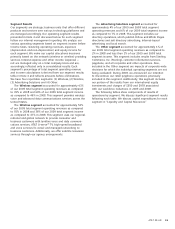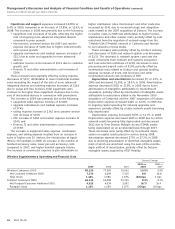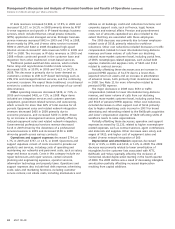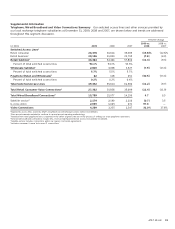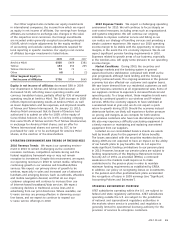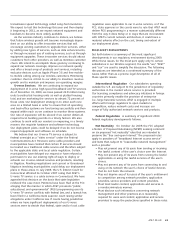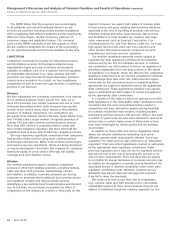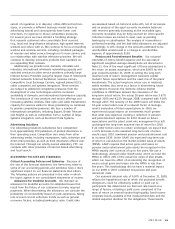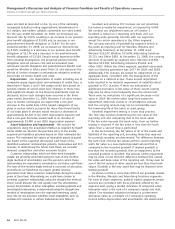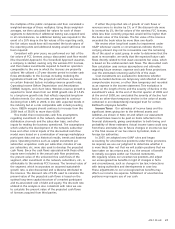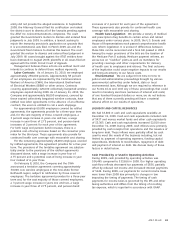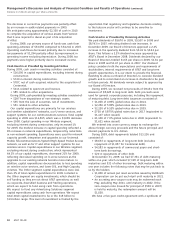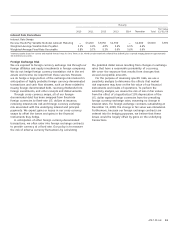AT&T Wireless 2009 Annual Report Download - page 45
Download and view the complete annual report
Please find page 45 of the 2009 AT&T Wireless annual report below. You can navigate through the pages in the report by either clicking on the pages listed below, or by using the keyword search tool below to find specific information within the annual report.
AT&T 09 AR 43
regulation were applicable to our U-verse services, or if the
FCC, state agencies or the courts were to rule that AT&T must
deliver PEG programming in a manner substantially different
from the way it does today or in ways that are inconsistent
with AT&T’s current network architecture, it could have a
material adverse effect on the cost, timing and extent of
our deployment plans.
REGULATORY DEVELOPMENTS
Set forth below is a summary of the most significant
developments in our regulatory environment during 2009.
While these issues, for the most part, apply only to certain
subsidiaries in our Wireline segment, the words “we,” “AT&T”
and “our” are used to simplify the discussion. The following
discussions are intended as a condensed summary of the
issues rather than as a precise legal description of all of
these specific issues.
International Regulation Our subsidiaries operating
outside the U.S. are subject to the jurisdiction of regulatory
authorities in the market where service is provided.
Our licensing, compliance and advocacy initiatives in foreign
countries primarily enable the provision of enterprise
(i.e., large business) services. AT&T is engaged in multiple
efforts with foreign regulators to open markets to
competition, reduce network costs and increase our
scope of fully authorized network services and products.
Federal Regulation A summary of significant 2009
federal regulatory developments follows.
Net Neutrality On October 22, 2009, the FCC adopted
a Notice of Proposed Rulemaking (NPRM) seeking comment
on six proposed “net neutrality” rules that are intended to
preserve the “free and open Internet.” The proposed rules
apply to providers of “broadband Internet access service”
and state that, subject to “reasonable network management,”
such a provider:
• Maynotpreventanyofitsusersfromsendingorreceiving
the lawful content of the user’s choice over the Internet.
• Maynotpreventanyofitsusersfromrunningthelawful
applications or using the lawful services of the user’s
choice.
• Maynotpreventanyofitsusersfromconnectingtoand
using on its network the user’s choice of lawful devices
that do not harm the network.
• Maynotdepriveanyofitsusersoftheuser’sentitlement
to competition among network providers, application
providers, service providers and content providers.
• Musttreatlawfulcontent,applicationsandservicesin
a nondiscriminatory manner.
• Mustdisclosesuchinformationconcerningnetwork
manage ment and other practices as is reasonably
required for users and content, application and service
providers to enjoy the protections specified in these rules.
transmission speed technology called Long-Term Evolution.
We expect to test this technology this year and then deploy
it beginning in 2011, as we expect network equipment and
handsets to become more widely available.
As the wireless industry continues to mature, we believe
that future wireless growth will become increasingly depen-
dent on our ability to offer innovative services that will
encourage existing customers to upgrade their services, either
by adding new types of services, such as data enhancements,
or through increased use of existing services, such as through
equipment upgrades. These innovative services should attract
customers from other providers, as well as minimize customer
churn. We intend to accomplish these goals by continuing to
expand our network coverage, improve our network quality
and offer a broad array of products and services, including
exclusive devices such as Apple iPhone 3G and free mobile-
to-mobile calling among our wireless customers. Minimizing
customer churn is critical to our ability to maximize revenue
growth and to maintain and improve our operating margins.
U-verse Services We are continuing to expand our
deployment of U-verse high-speed broadband and TV services.
As of December 31, 2009, we have passed 22.8 million living
units (constructed housing units as well as platted housing
lots) and are marketing the services to almost 72 percent of
those units. Our deployment strategy is to enter each new
area on a limited basis in order to ensure that all operating
and back-office systems are functioning successfully and then
expand within each as we continue to monitor these systems.
Our rate of expansion will be slowed if we cannot obtain all
required local building permits in a timely fashion. We also
continue to work with our vendors on improving, in a timely
manner, the requisite hardware and software technology.
Our deployment plans could be delayed if we do not receive
required equipment and software on schedule.
We believe that our U-verse TV service is subject to
federal oversight as a “video service” under the Federal
Communications Act. However, some cable providers and
municipalities have claimed that certain IP services should
be treated as a traditional cable service and therefore subject
to the applicable state and local cable regulation. Certain
municipalities have delayed our request or have refused us
permission to use our existing right-of-ways to deploy or
activate our U-verse-related services and products, resulting
in litigation. Pending negotiations and current or threatened
litigation involving municipalities could delay our deployment
plans in those areas. In July 2008, the U.S. District Court for
Connecticut affirmed its October 2007 ruling that AT&T’s
U-verse TV service is a cable service in Connecticut. We have
appealed that decision on the basis that state legislation
rendered the case moot. Petitions have been filed at the FCC
alleging that the manner in which AT&T provisions “public,
educational, and governmental” (PEG) programming over its
U-verse TV service conflicts with federal law, and a lawsuit has
been filed in a California state superior court raising similar
allegations under California law. If courts having jurisdiction
where we have significant deployments of our U-verse
services were to decide that federal, state and/or local cable


